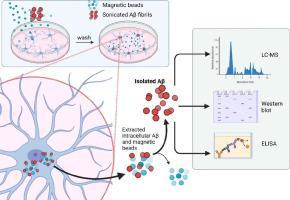当前位置:
X-MOL 学术
›
Mol. Cell. Neurosci.
›
论文详情
Our official English website, www.x-mol.net, welcomes your feedback! (Note: you will need to create a separate account there.)
Amyloid-β deposits in human astrocytes contain truncated and highly resistant proteoforms
Molecular and Cellular Neuroscience ( IF 3.5 ) Pub Date : 2024-01-19 , DOI: 10.1016/j.mcn.2024.103916 C. Beretta , E. Svensson , A. Dakhel , M. Zyśk , J. Hanrieder , D. Sehlin , W. Michno , A. Erlandsson
Molecular and Cellular Neuroscience ( IF 3.5 ) Pub Date : 2024-01-19 , DOI: 10.1016/j.mcn.2024.103916 C. Beretta , E. Svensson , A. Dakhel , M. Zyśk , J. Hanrieder , D. Sehlin , W. Michno , A. Erlandsson

|
Alzheimer's disease (AD) is a neurodegenerative disorder that develops over decades. Glial cells, including astrocytes are tightly connected to the AD pathogenesis, but their impact on disease progression is still unclear. Our previous data show that astrocytes take up large amounts of aggregated amyloid-beta (Aβ) but are unable to successfully degrade the material, which is instead stored intracellularly. The aim of the present study was to analyze the astrocytic Aβ deposits composition in detail in order to understand their role in AD propagation. For this purpose, human induced pluripotent cell (hiPSC)-derived astrocytes were exposed to sonicated Aβ fibrils and magnetic beads. Live cell imaging and immunocytochemistry confirmed that the ingested Aβ aggregates and beads were transported to the same lysosomal compartments in the perinuclear region, which allowed us to successfully isolate the Aβ deposits from the astrocytes. Using a battery of experimental techniques, including mass spectrometry, western blot, ELISA and electron microscopy we demonstrate that human astrocytes truncate and pack the Aβ aggregates in a way that makes them highly resistant. Moreover, the astrocytes release specifically truncated forms of Aβ via different routes and thereby expose neighboring cells to pathogenic proteins. Taken together, our study establishes a role for astrocytes in mediating Aβ pathology, which could be of relevance for identifying novel treatment targets for AD.
中文翻译:

人类星形胶质细胞中的淀粉样蛋白-β沉积物含有截短且高度耐药的蛋白质形式
阿尔茨海默氏病 (AD) 是一种几十年来发展的神经退行性疾病。包括星形胶质细胞在内的胶质细胞与 AD 发病机制密切相关,但它们对疾病进展的影响仍不清楚。我们之前的数据表明,星形胶质细胞吸收了大量聚集的β-淀粉样蛋白(Aβ),但无法成功降解该物质,而是储存在细胞内。本研究的目的是详细分析星形细胞 Aβ 沉积物的组成,以了解它们在 AD 传播中的作用。为此,将人诱导多能细胞 (hiPSC) 衍生的星形胶质细胞暴露于超声处理的 Aβ 原纤维和磁珠中。活细胞成像和免疫细胞化学证实,摄入的 Aβ 聚集体和珠子被转运到核周区域的相同溶酶体区室,这使我们能够成功地将 Aβ 沉积物与星形胶质细胞分离。使用一系列实验技术,包括质谱、蛋白质印迹、ELISA 和电子显微镜,我们证明人类星形胶质细胞以一种使其具有高度抵抗力的方式截断和包装 Aβ 聚集体。此外,星形胶质细胞通过不同途径释放特异截短形式的 Aβ,从而使邻近细胞暴露于致病蛋白。总而言之,我们的研究确定了星形胶质细胞在介导 Aβ 病理学中的作用,这可能与确定 AD 的新治疗靶点相关。
更新日期:2024-01-19
中文翻译:

人类星形胶质细胞中的淀粉样蛋白-β沉积物含有截短且高度耐药的蛋白质形式
阿尔茨海默氏病 (AD) 是一种几十年来发展的神经退行性疾病。包括星形胶质细胞在内的胶质细胞与 AD 发病机制密切相关,但它们对疾病进展的影响仍不清楚。我们之前的数据表明,星形胶质细胞吸收了大量聚集的β-淀粉样蛋白(Aβ),但无法成功降解该物质,而是储存在细胞内。本研究的目的是详细分析星形细胞 Aβ 沉积物的组成,以了解它们在 AD 传播中的作用。为此,将人诱导多能细胞 (hiPSC) 衍生的星形胶质细胞暴露于超声处理的 Aβ 原纤维和磁珠中。活细胞成像和免疫细胞化学证实,摄入的 Aβ 聚集体和珠子被转运到核周区域的相同溶酶体区室,这使我们能够成功地将 Aβ 沉积物与星形胶质细胞分离。使用一系列实验技术,包括质谱、蛋白质印迹、ELISA 和电子显微镜,我们证明人类星形胶质细胞以一种使其具有高度抵抗力的方式截断和包装 Aβ 聚集体。此外,星形胶质细胞通过不同途径释放特异截短形式的 Aβ,从而使邻近细胞暴露于致病蛋白。总而言之,我们的研究确定了星形胶质细胞在介导 Aβ 病理学中的作用,这可能与确定 AD 的新治疗靶点相关。



























 京公网安备 11010802027423号
京公网安备 11010802027423号